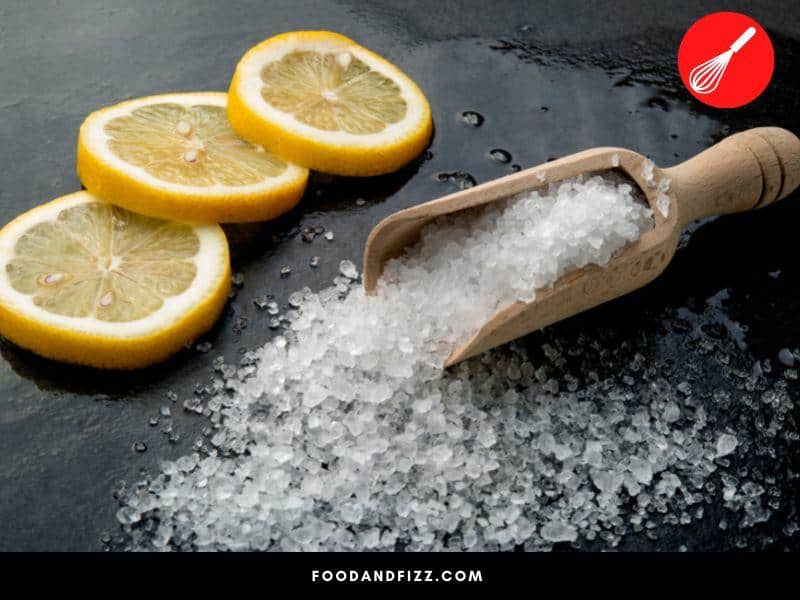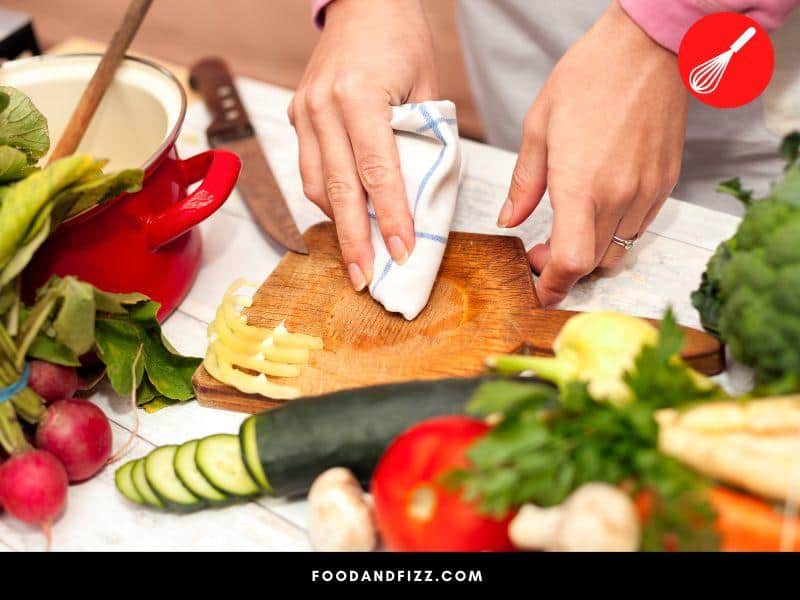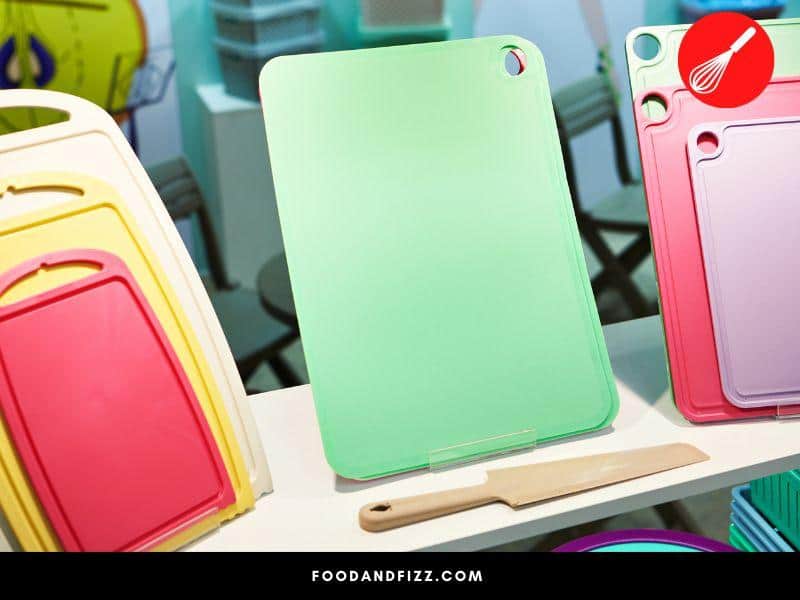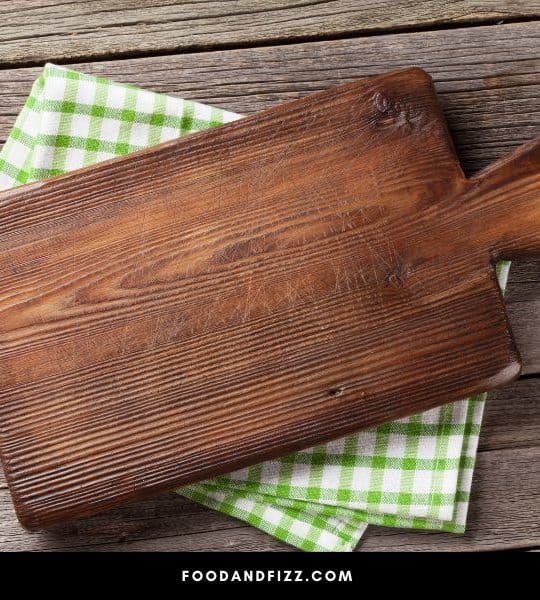Seeing black spots on your cutting board can be a little distressing, especially if you are a neat freak. It can understandably be frustrating to see this random, rogue kitchen item resisting the established kitchen cleaning system you have so carefully crafted.
A clean cutting board with black spots – what happened and can you still save it?
How do you remove black spots on your cutting board?
How to Remove Black Spots On Cutting Board
To remove black spots on your cutting board, you can wash with dish soap and hot water and scrub with a brush, use a baking soda paste, use salt and lemon, use a vinegar solution, diluted bleach solution, or hydrogen peroxide.

How to Remove Black Spots On Cutting Board
If you discover black spots on your cutting board, you can still save it by trying any one of the following solutions:
1. Wash With Hot Water and Dish Soap
Sometimes stains can be removed by taking just a little extra time to wash and scrub. Wash your cutting board in warm water and dish soap and use a cleaning brush or scouring pad to scrub the stains out.
If it is hardened food debris or staining from food, the brush will help scrape it away.
Dishwashers do not always get this stuff out, especially if they are hardened food debris. Sometimes a brush or scrub and some manual labor are needed.
2. Baking Soda Paste
Make a paste by mixing baking soda with water or lemon juice. Rub all over your cutting board and leave it on for a few minutes. Use a sponge or brush to rinse it off.
Baking soda is such an effective natural cleaner because it dissolves dirt and grime almost instantly, and absorbs odors in the process.
It is mildly abrasive and can “lift” dirt off of surfaces. Most foul odors are acidic and because of baking soda’s alkali nature, it is able to neutralize those odors and absorb them, resulting in a clean, odor-free surface.
Care should be taken though if you have a wooden cutting board, especially one that is treated and coated with natural oils as baking soda may react with the oils and cause even more staining.
3. Salt and Lemon Juice
Salt is a natural abrasive and effective natural cleaner. Simply sprinkle some kosher salt or coarse salt over your cutting board. How much to add depends on how big your cutting board is.
Take one lemon and cut it in half, squeezing the juice over the salt. Then, using the same lemon half as a scrub, start scrubbing your cutting board using small, circular motions, concentrating on the black spots until they are removed.
After that, gently wipe away with a towel or lightly rinse with water before drying.
Wooden cutting boards may need to be conditioned with oil after this process.

4. Vinegar Solution
Especially if the black spots on your cutting board are due to mold, a vinegar solution is an effective way to remove them.
Vinegar is a powerful mold killer and is thought to kill 82% of known mold species and can prevent it from happening again. It is safe to use and safe to eat, making it ideal for cleaning your cutting board.
Simply mix white vinegar with water at a 1:1 ratio. Spray or apply on your cutting board, especially on the black spots, and leave to sit for about 5 minutes.
Use a brush or sponge to scrub away the spots, or you can use baking soda or baking soda paste.
5. Vinegar and Baking Soda Paste
The combination of vinegar and baking soda is one of the most powerful cleaning combinations you can use for cleaning your kitchen.
Baking soda is an alkali that is mildly abrasive and dissolves dirt and grease, while vinegar is an acid that can break down minerals in water that can cause stains.
When combined, the acid in vinegar breaks down the compounds in baking soda to release carbon dioxide gas and helps remove dirt from surfaces.
As mentioned, vinegar is also an effective natural mold cleaner so if your stain is caused by mold, it can get rid of them.
Simply mix equal parts vinegar and baking soda to form a paste, apply over the stains and let sit for 5 minutes. Rinse with soapy water after.
6. Diluted Bleach Solution
Bleach can be used to clean and sanitize your cutting board. Simply dilute 1 tablespoon of unscented liquid bleach in 1 gallon of water.
Apply to the surface of the cutting board and let it stay on for at least 2 minutes. Use a sponge or scrub then rinse the cutting board with warm water.
Bleach takes a little bit of time to work on stains so allowing it to sit for a little while gives it time to work.
Make sure though, to not soak your cutting board for too long especially if it’s made of wood, as wood cutting boards are not meant to be in the water for a long time as they can absorb too much water and warp.
Bleach can also be corrosive for plastic boards so it is important to dilute it and not soak it for too long.
7. Hydrogen Peroxide
Like bleach, a 3% hydrogen peroxide solution is effective at disinfecting and sanitizing, and like vinegar, is effective at killing mold. It is inexpensive, safe, and readily available in stores.
You can dilute the hydrogen peroxide before applying it to the surface of your cutting board, or if the stains are caused by mold, you can use a spray bottle and spray it undiluted on the black spots. Allow it to sit for about 10 minutes, then proceed to rinse.
There are many things you can try to remove black spots on your cutting board. All the methods we outlined above are safe and natural and suitable for use on something that comes into contact with the food we eat.
What Causes Black Spots On Cutting Boards?
Black spots on your cutting board are likely caused by any one of the following:
1. Mold
Because cutting boards like wood are porous, juices from the food we prepare, as well as when we wash them, can seep into the wood and cause the mold to grow from the inside.
Mold loves moisture and will pretty much grow on any kind of organic matter. Making sure to clean your cutting boards properly after each use, and allowing them to dry properly before storing will minimize this, and minimize growths of any kind in your kitchen. (Read about Moldy Food Left In Oven).
2. Hardened food debris or stains
Sometimes black spots are caused by food stains or food debris that have hardened over time.
Scrubbing food stuff off of the cutting boards immediately after using them and not allowing them to dry on the surface will prevent this hardening and this build-up, and can also prevent the growth of mold and other bacteria.

3. Chemical Reaction Between Knives and Board
Sometimes the materials used in your knives react with the materials on the cutting board and can cause staining.
Types of Cutting Boards and Their Uses
There are many different types of cutting boards available on the market, and each of them have their distinct advantages and disadvantages.
We’ll explore some of them below.
1. Wood Cutting Boards
Wooden cutting boards are a popular choice because not only are they aesthetically pleasing, but if properly cared for, they can last a really long time.
They can be used for chopping your favorite food and other kitchen preparations and can also be a very pretty, Instagram and Pinterest-worthy serving platter.
There are many types of wooden cutting boards to choose from and an important thing to remember about them is, as they are porous in nature, they cannot be soaked in water as they may warp and splinter.
They also need to be conditioned with food-safe oils to maintain their condition. A helpful guide to caring for wooden cutting boards can be found here.

2. Bamboo Cutting Boards
Bamboo is a nice option if you do not want a regular wooden cutting board. It is more sustainable, non-porous, and can be equally as stylish as wooden boards.
They last long, are more resistant to moisture and therefore bacteria, and can last a long time The naturally hard surface though can cause your knives to get dull more quickly.
3. Plastic Cutting Boards
Plastic cutting boards are affordable, light, and easy to clean as they are dishwasher safe. You can buy several of them and allot their use for different kinds of food.
However, they can scar quite easily from knives, and heavily scarred plastic cutting boards can be a breeding ground for bacteria. It is important to replace them at this point.

4. Glass Cutting Boards
While it is more hygienic and very easy to clean and looks good when used to present food, glass cutting boards are the least recommended type of cutting board, at least from the perspective of someone who does a lot of chopping.
Besides the unpleasant sound created by a hard knife on glass, the slippery surface of the glass is not very safe especially if you chop a lot and you chop fast. One little slip of the knife or if the cutting board moves while you are chopping, you are risking a serious injury.
5. Rubber Cutting Board
Rubber cutting boards are easy to clean and are thus not prone to bacterial contamination, do not get the scars and cuts of plastic cutting boards, and do not need the regular oil conditioning maintenance of wooden cutting boards.
They are non-porous, non-slip, and are a safe option to use. Rubber cutting boards were made popular by Japanese sushi chefs, so if you’re feeling like channeling one, this might be a good choice.
There are many other different types of cutting boards available that you can choose from, some of them a combination of the materials outlined above.
In choosing what cutting board to get for your home, it is important to take into consideration what you will mostly be using them for, and how much time you can spend in taking care of and maintaining them.
Regardless of the type of cutting board, it is important to properly clean and sanitize them after each use to prevent mold and bacteria from growing. But some types of chopping boards require more specific types of maintenance over others.
Tips to Prevent Black Spots on Cutting Board
Regardless of the type of cutting board you own, following these tips will help ensure that you maintain their aesthetic look and prevent mold and other bacteria from growing on them.
1. Clean As You Go
Always rinse and wash your chopping board immediately after using them. Use warm water with soap to remove bits of food. Do not allow stains to settle or food to harden as they will be more difficult to remove when allowed to sit.
2. Use Separate Chopping Boards for Raw Meat and Vegetables
You do not have to get a one cutting board for every type of food but at least get one each for raw meat and one for other types of food.
This makes it more hygienic and prevents you from getting a food-borne illness due to cross-contamination. If you only have space for one or can only afford one, make sure to completely clean and sanitize your board after each use.
3. Follow Manufacturer’s Instructions in Proper Care
Wooden cutting boards cannot be soaked in water and need to be conditioned regularly with food-safe oil, plastic cutting boards are dishwasher safe but should not be dried in the dishwasher because they can warp.
Following the manufacturer’s specific care instructions for your cutting board will ensure that you will be with it for a long time, and also ensure your safety in food preparations.
4. Always Allow Your Cutting Board to Dry Completely Before Storing
Always make sure your cutting boards are completely dry before storing. Mold loves moisture and storing your cutting boards half-dry will only make it a welcome, breeding ground for bacteria.
5. Replace Worn Out Cutting Boards
And finally, no matter how much you love your cutting board, replace it when it has become worn out or when there is damage to your board.
If it is deeply scarred, grooved, or has a safety precaution missing (like the rubber doesn’t hold in place anymore or something like that), it is best practice to replace it. This ensures the safety of your food and your safety while using it.
Frequently Asked Questions to How to Remove Black Spots on Cutting Board
Is Mold on Cutting Board Dangerous?
Mold is generally not toxic in itself but some types like black mold produce mycotoxins which, when ingested, can cause serious harm to our bodies. Molds on cutting boards are not only unsanitary and potentially unsafe, but they also destroy the visual appeal of food too.
How Do I Prevent Mold On My Cutting Board?
To prevent mold from forming on your cutting board, make sure to properly and thoroughly clean them according to the type of cutting board you own and make sure they are completely dry prior to storing.
Conclusion to How to Remove Black Spots On Cutting Board
Cutting boards with black spots do not necessarily have to be discarded right away. There are methods you can try to clean them and make them as good as new.
However, if none of the methods work, it might be time to part with it and invest in a new one. There are many available options on the market that are affordable, safe, and easy to use, and there is definitely something out there that will fit your specific needs.

